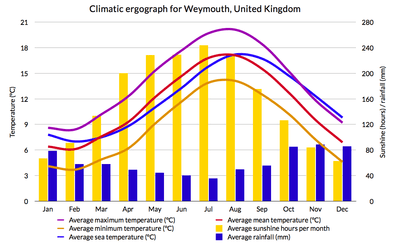Ergograph
An ergograph is a graph that shows a relation between human activities, or agricultural/climate factors, and a seasonal year. The name was coined by Dr. Arthur Geddes of the University of Edinburgh. It can either be a polar coördinate (circular) or a cartesian coördinate (rectangular) graph, and either a line graph or a bar graph.[1][2][3]

In cartesian form, the X axis is marked for the months of the year, and the Y axis is marked with the scale(s) of the activity/activities.[1][2] For example, in the ergograph to the right, the Y axis is marked with both temperature and rainfall/sunshine scales.
In polar form, the months of the year are marked around the circumference, forming 30° sectors. Concentric lines display the proportions of time (in hours per day) devoted to each of the activities. The time scale, ranging from 0 to 24 hours per day, is along the radius of the circle, and is a square root scale.[1][2] This form of an ergograph is also known as a polar line graph or (because the data form "bands" on the graph) a polar strata graph or polar layer graph, the "polar" denoting the system of polar coordinates used on the graph.[3]
Ergographs can record human activities or agricultural/climate information, such as rainfall, temperature, humidity, crop types, and crop acreage.[1][2]
References
- 1 2 3 4 Rameshwar Prasad Misra and A. Ramesh (1989). Fundamentals of cartography (2nd ed.). Concept Publishing Company. p. 438. ISBN 9788170222224.
- 1 2 3 4 Francis John Monkhouse (2007). A Dictionary of Geography (2nd ed.). Aldine Transaction. p. 127. ISBN 9780202361314.
- 1 2 Graham T. Richardson (1985). Illustrations. Humana Press. pp. 49–50. ISBN 9780896030701.
Further reading
- Institute of British Geographers (1950). Transactions and papers — Institute of British Geographers. G. Philip (16–19): 2,184. Missing or empty
|title=(help)